![]()
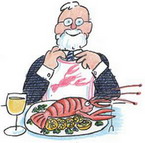
There’s more than one way to eat a duck.
L’aiguillette de canard au citron
(Lemon duck breasts)
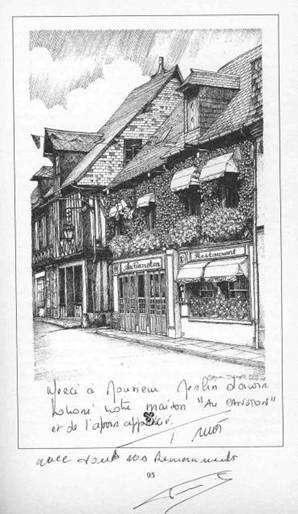 Guided by Mirabel Osler’s A Spoon with Every Course, I once ate at Au Caneton, a wonderful restaurant in Orbec off the tourist track in Normandy, southwest of Rouen. My first visit was with Frank on the journey narrated at length in Through Darkest Gaul with Trencher and Tastevin. The second time I travelled with Mary, who was so taken with the restaurant and its cuisine that we stayed over at a local b&b chateau and ate there three times in two days.
Guided by Mirabel Osler’s A Spoon with Every Course, I once ate at Au Caneton, a wonderful restaurant in Orbec off the tourist track in Normandy, southwest of Rouen. My first visit was with Frank on the journey narrated at length in Through Darkest Gaul with Trencher and Tastevin. The second time I travelled with Mary, who was so taken with the restaurant and its cuisine that we stayed over at a local b&b chateau and ate there three times in two days.
Au Caneton is an elegant husband-and-wife restaurant that functions with very little extra help. The chef, Didier Tricot, is locally noted for his L’aiguillette de canard au citron. Is it original? “I never invent,” he says dismissively, “but I may adapt.”
So do I. My version of his duck breast recipe has become a tradition in our household. I’ve changed it to a degree that Mssr. Tricot would probably not approve of, but I lack his expertise. Part of the skill of cooking, I’ve learned, is acknowledging one’s limitations and still producing something agreeably edible. (I know a world-famous author of multitudinous cookbooks who admits that she can’t bake.) Here’s my own modest version of Mssr. Tricot’s splendid recipe. I cooked it again last night and Mary was gratifyingly enthusiastic, as always.
L’aiguillette de canard au citron
(Lemon duck breasts)
salt and pepper
2 duck breasts
2 tsp. sugar
1 fl. oz. wine (or balsamic)vinegar
8 fl. oz. good veal or chicken stock
grated zest and juice of ½ lemon
2 tsp. Grand Marnier
Heat a small frying pan, without oil. At the same time begin to heat a small heavy roasting pan in the oven at 200°C/400°F/Gas Mark 6.
Salt the duck breasts lightly on the skin only.
Brown them skin side down in the hot frying pan. The object is to extract the fat and crisp the skins without drying out the flesh.
As the skins brown, add the sugar. When it starts to caramelize, add the vinegar.
Turn breasts in the sweet/sour mixture, coating them well. Transfer to the hot roasting pan skin side up, uncovered, and cook in the oven for 20 minutes, then check. How much longer you cook them will depend on how well done you want them.
While the duck is cooking, bring the stock to a boil in a separate pan and simmer until it starts to thicken. Add the Grand Marnier, the lemon juice and most of the zest. When the breasts are done, add as much of the pan’s fatty juices as your taste and diet will permit.
It’s customary in such recipes to slice the breast at an angle and fan out the slices. This makes a great photo but allows it to cool quicker than you can eat it. I prefer to leave it whole and have some warmth still left in the last bite.
-----------------------------------
Original recipe from Au Caneton, Orbec; as set down by Shaun Hill for Mirabel Osler’s A Spoon with Every Course and further adapted for my travel journal, Through Darkest Gaul with Trencher and Tastevin.
___________________________________________________________________________________
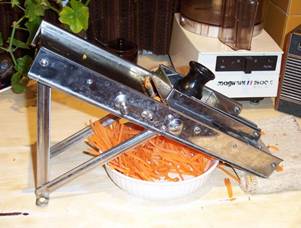 I make this rich dish even richer by accompanying it with semi-caramelized carrots julienne, sauteed very slowly in butter and a bit of stock. The only way I’ve found to cut them properly is with that massive piece of kitchen machinery, the Braun mandoline. It’s an instrument best not played with bare fingers; the slider is an essential accessory. A folded oven glove is under the leading edge because the raw steel will leave permanent calling cards on your work surface. But there are non-skid rubber feet on the rear support. Curious.
I make this rich dish even richer by accompanying it with semi-caramelized carrots julienne, sauteed very slowly in butter and a bit of stock. The only way I’ve found to cut them properly is with that massive piece of kitchen machinery, the Braun mandoline. It’s an instrument best not played with bare fingers; the slider is an essential accessory. A folded oven glove is under the leading edge because the raw steel will leave permanent calling cards on your work surface. But there are non-skid rubber feet on the rear support. Curious.
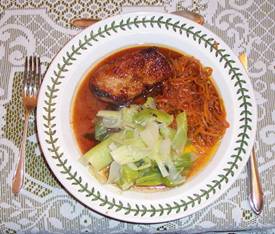 Mary relieves the wicked richness with simply simmered leeks. Here’s our dinner, dished up for consumption rather than display.
Mary relieves the wicked richness with simply simmered leeks. Here’s our dinner, dished up for consumption rather than display.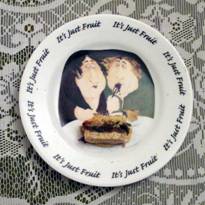
We polished off the meal with a tiny remaining piece of mincemeat and apricot streusel. As the dish says reassuringly, it’s just fruit.
Mirabel’s book was reprinted in paper as The Elusive Truffle. Her preferred title was The Elusive Salamander, for reasons that become evident as you read it, but her first publisher insisted on A Spoon with Every Course, which applied only to the Normandy chaper. The paperback publisher reverted to the original title but insisted on truffle rather than salamander (too obscure), even though it bore no relation to the book’s content. Sigh.
The book is a masterpiece, so naturally both editions are out of print, but the paperback is curiously offered used through Amazon for as little as 99p. Snap it up—it’s one of the greatest French food/travel books ever written.
Return to TOP
Return to RECIPE INDEX